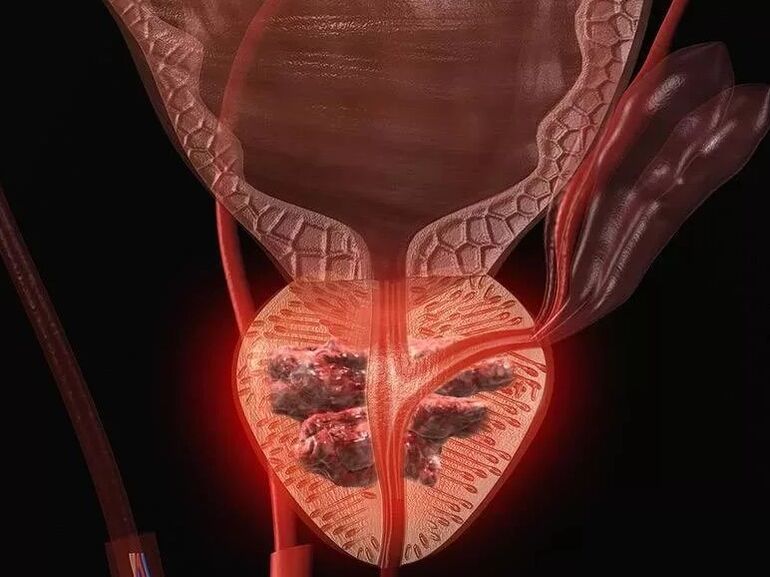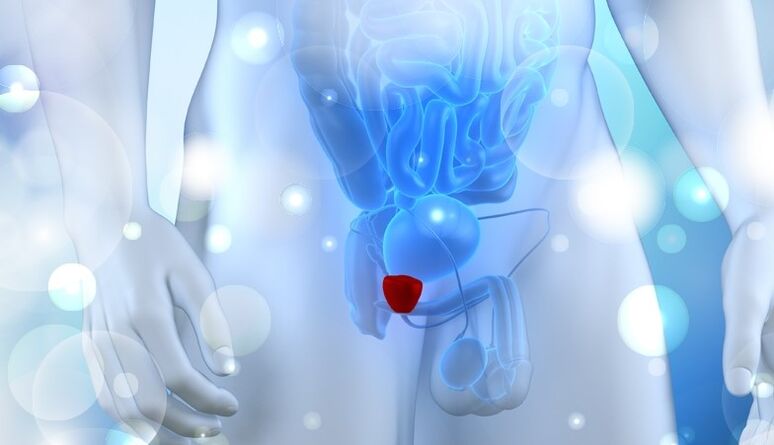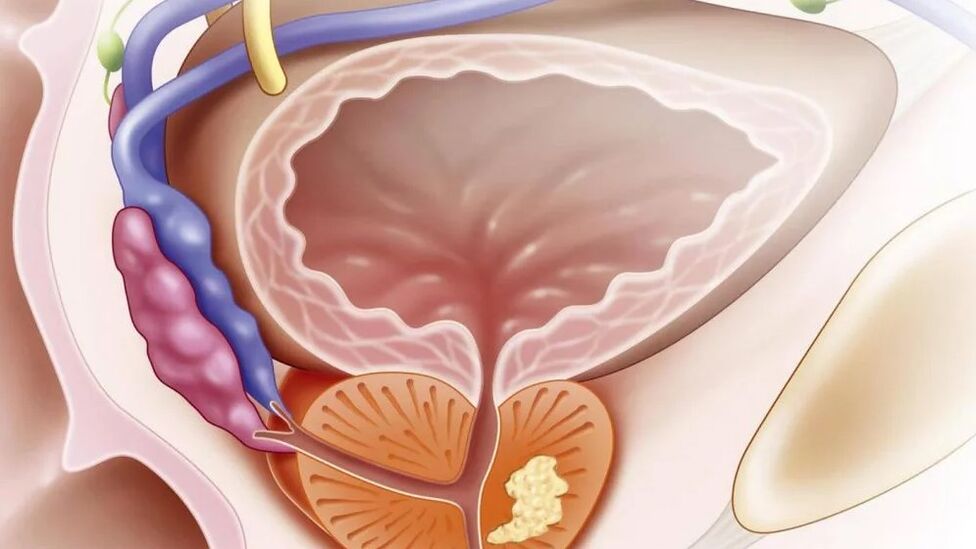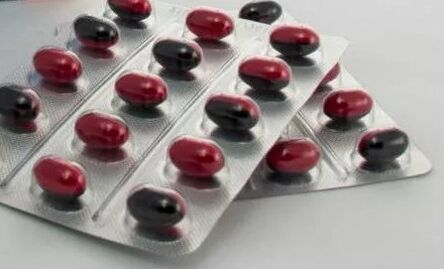
Prostatitis: consequencesIn the event of premature attraction for the urologist, acute bacterial prostatitis can lead to the formation of an abscess and edema of the prostate gland, which is capable not only to complicate urination, but to make it completely impossible.The latter, like inflammation, can cause serious intoxication of the body, characterized, among other things, by a high increase in temperature up to 40-41 ° C (with net temperature fluctuations to a degree).However, more often than not, complications of this type can be avoided, because the manifestations of prostatitis of this species generally force the patient not to delay the visit of a specialist.In the case of a chronic form of the disease, the symptoms of which are not so pronounced, the development of complications without appropriate and appropriate treatment is quite possible. Without appropriate medication and therapeutic effect, inflammation can spread to other organs of the genitarinary system, which can lead to development:Cystitis - inflammation of the bladder;Pyelonephritis - renal inflammation;
vesiculitis - inflammation of seed bubbles;Inflammation of the testicles and appendices of the testicles.It should be remembered that the inflammation of eggs and testicles is one of the most common complications and can cause male infertility, which, in turn, is treated for a long time, difficult and not always successful, therefore faster to treat prostatitis, the more likely to avoid complications of this type. In some cases, the consequence of chronic prostatitis can be its transition to a form of calculation. Calculation prostatitis is characterized by the formation of calculations (small pebbles) in the gland excavation channels, to get rid of what is very medication.In addition, the cause of prostatitis is a hormonal insufficiency caused by insufficient production of hormones with the sexual glands.The development of prostatitis is facilitated by a number of certain causes. Very often, signs of prostatitis manifest themselves in men who lead an irregular sex life, often undergo hypothermia and wounds.In addition, prostatitis can develop following a decrease in immunity, aggravating blood flow and lymphatic circulation in men of the small man's basin, due to hormonal insufficiency, which causes a certain level of androgynous failure.A factor contributing to the manifestation of prostatitis is also considered a number of infections that are sexually transmitted. Consequently, prostatitis often manifests in men after unprotected sex.There are 4 main forms of prostatitis: acute bacterial prostatitis, chronic bacterial prostatitis, non -bacterial prostatitis and prostatinia.In people under the age of 35, the disease generally takes place in the form of acute bacterial prostatitis. Bacterial prostatitis is called when there is a laboratory confirmation of the presence of infection.Most often, it turns out that it is chlamydia, trichomonase, gardnerellosis or gonorrhea. The infection enters the gland of the prostate of the urethra, the bladder, the rectum, through the blood and the lymphatic vessels of the basin.
However, recent studies prove that in most cases, infection is superimposed on existing disturbances in the structure of the fabric of the prostate and blood circulation. With non -bacterial prostatitis, bacteria cannot be isolated, although this does not exclude their presence. In elderly patients, chronic forms of the disease are more often diagnosed. Prostatodinia is called the presence of a clinical picture of prostatitis, a seal of the fabric of the prostate without signs of its inflammation.ClassificationIn accordance with the criteria of the American National Institute of Health (NIH USA), four categories of prostatitis are distinguished from 1995:Acute (bacterial) prostatitisChronic bacterial prostatitisChronic non -bacterial prostatitis / chronic pelvic pain (CP / CPPS)Chronic inflammatory pelvic pain syndrome (leukocytes are determined in the secret of prostate, urine and ejaculat)Non -inflammatory chronic pelvic pain syndrome, in which signs of inflammation are absentAsymptomatic chronic prostatitisCurrently, an international classification of prostatitis has been adopted, which is most complete and covering all types of inflammation:Category I. Acute prostatitis;Category II. Chronic bacterial prostatitis;Category III. Chronic Nebacterial Prostatitis / Chronic Pelvic Pain Syndrome is an infection in which an infection lasts more than 3 months is not detected;
Subcategory III A. Chronic inflammatory pelvic pain syndrome (leukocytes are determined in the secret of prostate);
Subcategory III B. Non-inflammatory chronic pelvic pain syndrome (there are no leukocytes in the secret of the prostate); Category IV. Proceeding with breathtaking chronic prostatitis (leukocytes are present in the secret of the prostate, the patient does not complaint, the disease is detected by chance).The treatment of prostatitis varies depending on the form of the disease in a man. Thus, bacterial prostatitis can occur both in acute form and as a chronic disease.Very often, non -bacterial prostatitis is also diagnosed as a chronic disease. Such a variety of prostatitis is also called chronic pelvic pain syndrome.In these patients, all the characteristic symptoms of prostatitis are observed, but there are no bacteria in the secret of the prostate.Acute bacterial prostatitis is characterized by rapid development. At the same time, a person suffers from intense pain, there are signs of general poisoning. Symptoms of the chronic form of the disease manifest are much less. In this case, the disease is gradually manifested.And if the prostatitis of the acute form, as a rule, ends with the complete healing of the disease, then with chronic prostatitis, relapses appear quite often. This should be taken into account in the treatment of prostatitis at home. In addition, in the presence of ignited stones in the prostate gland, disease therapy is a more complex process.
With non -bacterial prostatitis (chronic pelvic pain), a person develops intense pain that is located in the pelvic area, the genitals and the perineum. There is no sign of inflammation in the prostate.This disease is common in modern men from different age groups, but most often, the disease affects people aged 35 to 45. Until today, experts express several hypotheses on the causes of this form of prostatitis. There is therefore a theory that this syndrome causes damage to the tissues of a bacterial prostate. In addition, there is an opinion that the disease manifests itself due to the urine that falls into the gland of the prostate.As we have already said, the acute and chronic course of the disease is possible. In this case, the appearance of acute prostatitis is most often caused by gram negative bacteria.This form of the disease is relatively easy to diagnose and treat by taking antibiotics. At the same time, cases of chronic non -bacterial prostatitis are very often found in men, which is more difficult to diagnose and has no connection with a certain infectious lesion.Therefore, in the case of chronic prostatitis, treatment with antibiotics will not be able to give the right effect. According to statistics, around 35% of men over fifty years old, chronic prostatitis.Treatment of chronic and acute prostatitisIn the case of signs of prostatitis, both acute and chronic, you should consult a urologist, which will establish what type of diagnosis takes place, and would also help to cure the disease and strengthen the body as a whole. It should be remembered that this also applies to the two types of prostatitis, each being able to lead to their complications.Primary receptionThe main reception of a specialist implies an investigation and an examination of the patient (including the rectal, which allows you to determine the degree and nature of the increase in the prostate gland), as well as the appointment of the necessary tests and other diagnostic measures.The first and important sign of prostatitis is an altered urination which causes discomfort. Another sign of the disease is rapid urination, but in which Urina comes out in small portions.Symptoms of the acute form of the disease
The disease is suddenly formed and is characterized by pronounced manifestations.Frequent painful urilation;pain during defecation;alteration of power;Pain in the groin, in the sacrum and anus area;high perspiration;fatigue.Each male body is individual and the symptoms can manifest itself separately, or at the same time.Signs of a chronic form of the diseaseChronic prostatitis is generally characterized by the same signs, however, it proceeds with less pronounced symptoms.In addition, the following manifestations can be observed:increased irritability;A feeling of overflowing bladder;deterioration of quality or lack of orgasm;Selection during the urethra defecation.The very first signs of prostatitis, to which a man should certainly be careful and contact the urologist:Severe pain during urination. At the end of the process, an unpleasant burning sensation is felt.Improvement in body temperature.The feeling of not completely emptying the bladder.Discomfort in the crotch and groin area.Insufficient pressure of the jet when visiting the toilet.Prostatitic treatment is carried out according to the form of the disease. Acute inflammation is an indication of patient hospitalization in the urological hospital, chronic patients are under treatment at home. If the cause of the disease was a sexually transmitted infection, the two partners should take antibiotics. In the treatment of acute prostatitis, it is important that systemic antibacterial treatment is important.
The main groups of drugs include:Antibiotics. Used in the form of tablets, capsules, candles, syrups and other types.Anti-inflammatory drugs.Spasmalgotics and analgesic.Preparations to increase immunity.Vitamins.Anti -stress drugs.MassageThis procedure is one of the most effective methods for treating prostatitis. Thanks to her, accumulated in the gland of the prostate, the secret was out, then removed independently through the urethra. In addition, prostate massage helps improve blood supply to the gland fabric, which increases the effectiveness of antibacterial and local treatment.PhysiotherapyPhysiotherapeutic treatment helps improve the trophism of the fabric of the prostate gland and accelerate the recovery process. The following physiotherapy methods are possible:Transrectal microwave hyperthermia,Diadinamophoresis,Laser therapy,Phonophoresis with ultrasound.ExerciseThe main signs of the diseaseA disease like prostatitis in most men suddenly develops. In the patient, the temperature increases sharply, a feeling of weakness, the fever appears. The main sign of inflammation of the prostate is intense pain in the perineum, which gives the pubic area, at the anal opening, to the sacrum. During urination, defecation and with any other tension of the pelvic muscles, pain increases.


ClassificationIn accordance with the criteria of the American National Institute of Health (NIH USA), four categories of prostatitis are distinguished from 1995:Acute (bacterial) prostatitisChronic bacterial prostatitisChronic non -bacterial prostatitis / chronic pelvic pain (CP / CPPS)Chronic inflammatory pelvic pain syndrome (leukocytes are determined in the secret of prostate, urine and ejaculat)Non -inflammatory chronic pelvic pain syndrome, in which signs of inflammation are absentAsymptomatic chronic prostatitisCurrently, an international classification of prostatitis has been adopted, which is most complete and covering all types of inflammation:Category I. Acute prostatitis;Category II. Chronic bacterial prostatitis;Category III. Chronic Nebacterial Prostatitis / Chronic Pelvic Pain Syndrome is an infection in which an infection lasts more than 3 months is not detected;
Subcategory III A. Chronic inflammatory pelvic pain syndrome (leukocytes are determined in the secret of prostate);
Subcategory III B. Non-inflammatory chronic pelvic pain syndrome (there are no leukocytes in the secret of the prostate); Category IV. Proceeding with breathtaking chronic prostatitis (leukocytes are present in the secret of the prostate, the patient does not complaint, the disease is detected by chance).The treatment of prostatitis varies depending on the form of the disease in a man. Thus, bacterial prostatitis can occur both in acute form and as a chronic disease.Very often, non -bacterial prostatitis is also diagnosed as a chronic disease. Such a variety of prostatitis is also called chronic pelvic pain syndrome.In these patients, all the characteristic symptoms of prostatitis are observed, but there are no bacteria in the secret of the prostate.Acute bacterial prostatitis is characterized by rapid development. At the same time, a person suffers from intense pain, there are signs of general poisoning. Symptoms of the chronic form of the disease manifest are much less. In this case, the disease is gradually manifested.And if the prostatitis of the acute form, as a rule, ends with the complete healing of the disease, then with chronic prostatitis, relapses appear quite often. This should be taken into account in the treatment of prostatitis at home. In addition, in the presence of ignited stones in the prostate gland, disease therapy is a more complex process.
With non -bacterial prostatitis (chronic pelvic pain), a person develops intense pain that is located in the pelvic area, the genitals and the perineum. There is no sign of inflammation in the prostate.This disease is common in modern men from different age groups, but most often, the disease affects people aged 35 to 45. Until today, experts express several hypotheses on the causes of this form of prostatitis. There is therefore a theory that this syndrome causes damage to the tissues of a bacterial prostate. In addition, there is an opinion that the disease manifests itself due to the urine that falls into the gland of the prostate.As we have already said, the acute and chronic course of the disease is possible. In this case, the appearance of acute prostatitis is most often caused by gram negative bacteria.This form of the disease is relatively easy to diagnose and treat by taking antibiotics. At the same time, cases of chronic non -bacterial prostatitis are very often found in men, which is more difficult to diagnose and has no connection with a certain infectious lesion.Therefore, in the case of chronic prostatitis, treatment with antibiotics will not be able to give the right effect. According to statistics, around 35% of men over fifty years old, chronic prostatitis.Treatment of chronic and acute prostatitisIn the case of signs of prostatitis, both acute and chronic, you should consult a urologist, which will establish what type of diagnosis takes place, and would also help to cure the disease and strengthen the body as a whole. It should be remembered that this also applies to the two types of prostatitis, each being able to lead to their complications.Primary receptionThe main reception of a specialist implies an investigation and an examination of the patient (including the rectal, which allows you to determine the degree and nature of the increase in the prostate gland), as well as the appointment of the necessary tests and other diagnostic measures.The first and important sign of prostatitis is an altered urination which causes discomfort. Another sign of the disease is rapid urination, but in which Urina comes out in small portions.Symptoms of the acute form of the disease
The disease is suddenly formed and is characterized by pronounced manifestations.Frequent painful urilation;pain during defecation;alteration of power;Pain in the groin, in the sacrum and anus area;high perspiration;fatigue.Each male body is individual and the symptoms can manifest itself separately, or at the same time.Signs of a chronic form of the diseaseChronic prostatitis is generally characterized by the same signs, however, it proceeds with less pronounced symptoms.In addition, the following manifestations can be observed:increased irritability;A feeling of overflowing bladder;deterioration of quality or lack of orgasm;Selection during the urethra defecation.The very first signs of prostatitis, to which a man should certainly be careful and contact the urologist:Severe pain during urination. At the end of the process, an unpleasant burning sensation is felt.Improvement in body temperature.The feeling of not completely emptying the bladder.Discomfort in the crotch and groin area.Insufficient pressure of the jet when visiting the toilet.Prostatitic treatment is carried out according to the form of the disease. Acute inflammation is an indication of patient hospitalization in the urological hospital, chronic patients are under treatment at home. If the cause of the disease was a sexually transmitted infection, the two partners should take antibiotics. In the treatment of acute prostatitis, it is important that systemic antibacterial treatment is important.
The main groups of drugs include:Antibiotics. Used in the form of tablets, capsules, candles, syrups and other types.Anti-inflammatory drugs.Spasmalgotics and analgesic.Preparations to increase immunity.Vitamins.Anti -stress drugs.MassageThis procedure is one of the most effective methods for treating prostatitis. Thanks to her, accumulated in the gland of the prostate, the secret was out, then removed independently through the urethra. In addition, prostate massage helps improve blood supply to the gland fabric, which increases the effectiveness of antibacterial and local treatment.PhysiotherapyPhysiotherapeutic treatment helps improve the trophism of the fabric of the prostate gland and accelerate the recovery process. The following physiotherapy methods are possible:Transrectal microwave hyperthermia,Diadinamophoresis,Laser therapy,Phonophoresis with ultrasound.ExerciseThe main signs of the diseaseA disease like prostatitis in most men suddenly develops. In the patient, the temperature increases sharply, a feeling of weakness, the fever appears. The main sign of inflammation of the prostate is intense pain in the perineum, which gives the pubic area, at the anal opening, to the sacrum. During urination, defecation and with any other tension of the pelvic muscles, pain increases.
Subcategory III A. Chronic inflammatory pelvic pain syndrome (leukocytes are determined in the secret of prostate);
Subcategory III B. Non-inflammatory chronic pelvic pain syndrome (there are no leukocytes in the secret of the prostate);

Treatment of chronic and acute prostatitisIn the case of signs of prostatitis, both acute and chronic, you should consult a urologist, which will establish what type of diagnosis takes place, and would also help to cure the disease and strengthen the body as a whole. It should be remembered that this also applies to the two types of prostatitis, each being able to lead to their complications.Primary receptionThe main reception of a specialist implies an investigation and an examination of the patient (including the rectal, which allows you to determine the degree and nature of the increase in the prostate gland), as well as the appointment of the necessary tests and other diagnostic measures.The first and important sign of prostatitis is an altered urination which causes discomfort. Another sign of the disease is rapid urination, but in which Urina comes out in small portions.Symptoms of the acute form of the disease
The disease is suddenly formed and is characterized by pronounced manifestations.Frequent painful urilation;pain during defecation;alteration of power;Pain in the groin, in the sacrum and anus area;high perspiration;fatigue.Each male body is individual and the symptoms can manifest itself separately, or at the same time.Signs of a chronic form of the diseaseChronic prostatitis is generally characterized by the same signs, however, it proceeds with less pronounced symptoms.In addition, the following manifestations can be observed:increased irritability;A feeling of overflowing bladder;deterioration of quality or lack of orgasm;Selection during the urethra defecation.The very first signs of prostatitis, to which a man should certainly be careful and contact the urologist:Severe pain during urination. At the end of the process, an unpleasant burning sensation is felt.Improvement in body temperature.The feeling of not completely emptying the bladder.Discomfort in the crotch and groin area.Insufficient pressure of the jet when visiting the toilet.Prostatitic treatment is carried out according to the form of the disease. Acute inflammation is an indication of patient hospitalization in the urological hospital, chronic patients are under treatment at home. If the cause of the disease was a sexually transmitted infection, the two partners should take antibiotics. In the treatment of acute prostatitis, it is important that systemic antibacterial treatment is important.
The main groups of drugs include:Antibiotics. Used in the form of tablets, capsules, candles, syrups and other types.Anti-inflammatory drugs.Spasmalgotics and analgesic.Preparations to increase immunity.Vitamins.Anti -stress drugs.MassageThis procedure is one of the most effective methods for treating prostatitis. Thanks to her, accumulated in the gland of the prostate, the secret was out, then removed independently through the urethra. In addition, prostate massage helps improve blood supply to the gland fabric, which increases the effectiveness of antibacterial and local treatment.PhysiotherapyPhysiotherapeutic treatment helps improve the trophism of the fabric of the prostate gland and accelerate the recovery process. The following physiotherapy methods are possible:Transrectal microwave hyperthermia,Diadinamophoresis,Laser therapy,Phonophoresis with ultrasound.ExerciseThe main signs of the diseaseA disease like prostatitis in most men suddenly develops. In the patient, the temperature increases sharply, a feeling of weakness, the fever appears. The main sign of inflammation of the prostate is intense pain in the perineum, which gives the pubic area, at the anal opening, to the sacrum. During urination, defecation and with any other tension of the pelvic muscles, pain increases.
Primary receptionThe main reception of a specialist implies an investigation and an examination of the patient (including the rectal, which allows you to determine the degree and nature of the increase in the prostate gland), as well as the appointment of the necessary tests and other diagnostic measures.The first and important sign of prostatitis is an altered urination which causes discomfort. Another sign of the disease is rapid urination, but in which Urina comes out in small portions.Symptoms of the acute form of the disease
The disease is suddenly formed and is characterized by pronounced manifestations.Frequent painful urilation;pain during defecation;alteration of power;Pain in the groin, in the sacrum and anus area;high perspiration;fatigue.Each male body is individual and the symptoms can manifest itself separately, or at the same time.Signs of a chronic form of the diseaseChronic prostatitis is generally characterized by the same signs, however, it proceeds with less pronounced symptoms.In addition, the following manifestations can be observed:increased irritability;A feeling of overflowing bladder;deterioration of quality or lack of orgasm;Selection during the urethra defecation.The very first signs of prostatitis, to which a man should certainly be careful and contact the urologist:Severe pain during urination. At the end of the process, an unpleasant burning sensation is felt.Improvement in body temperature.The feeling of not completely emptying the bladder.Discomfort in the crotch and groin area.Insufficient pressure of the jet when visiting the toilet.Prostatitic treatment is carried out according to the form of the disease. Acute inflammation is an indication of patient hospitalization in the urological hospital, chronic patients are under treatment at home. If the cause of the disease was a sexually transmitted infection, the two partners should take antibiotics. In the treatment of acute prostatitis, it is important that systemic antibacterial treatment is important.
The main groups of drugs include:Antibiotics. Used in the form of tablets, capsules, candles, syrups and other types.Anti-inflammatory drugs.Spasmalgotics and analgesic.Preparations to increase immunity.Vitamins.Anti -stress drugs.MassageThis procedure is one of the most effective methods for treating prostatitis. Thanks to her, accumulated in the gland of the prostate, the secret was out, then removed independently through the urethra. In addition, prostate massage helps improve blood supply to the gland fabric, which increases the effectiveness of antibacterial and local treatment.PhysiotherapyPhysiotherapeutic treatment helps improve the trophism of the fabric of the prostate gland and accelerate the recovery process. The following physiotherapy methods are possible:Transrectal microwave hyperthermia,Diadinamophoresis,Laser therapy,Phonophoresis with ultrasound.ExerciseThe main signs of the diseaseA disease like prostatitis in most men suddenly develops. In the patient, the temperature increases sharply, a feeling of weakness, the fever appears. The main sign of inflammation of the prostate is intense pain in the perineum, which gives the pubic area, at the anal opening, to the sacrum. During urination, defecation and with any other tension of the pelvic muscles, pain increases.
Symptoms of the acute form of the disease
The disease is suddenly formed and is characterized by pronounced manifestations.Frequent painful urilation;pain during defecation;alteration of power;Pain in the groin, in the sacrum and anus area;high perspiration;fatigue.Each male body is individual and the symptoms can manifest itself separately, or at the same time.Signs of a chronic form of the diseaseChronic prostatitis is generally characterized by the same signs, however, it proceeds with less pronounced symptoms.In addition, the following manifestations can be observed:increased irritability;A feeling of overflowing bladder;deterioration of quality or lack of orgasm;Selection during the urethra defecation.The very first signs of prostatitis, to which a man should certainly be careful and contact the urologist:Severe pain during urination. At the end of the process, an unpleasant burning sensation is felt.Improvement in body temperature.The feeling of not completely emptying the bladder.Discomfort in the crotch and groin area.Insufficient pressure of the jet when visiting the toilet.Prostatitic treatment is carried out according to the form of the disease. Acute inflammation is an indication of patient hospitalization in the urological hospital, chronic patients are under treatment at home. If the cause of the disease was a sexually transmitted infection, the two partners should take antibiotics. In the treatment of acute prostatitis, it is important that systemic antibacterial treatment is important.
The main groups of drugs include:Antibiotics. Used in the form of tablets, capsules, candles, syrups and other types.Anti-inflammatory drugs.Spasmalgotics and analgesic.Preparations to increase immunity.Vitamins.Anti -stress drugs.MassageThis procedure is one of the most effective methods for treating prostatitis. Thanks to her, accumulated in the gland of the prostate, the secret was out, then removed independently through the urethra. In addition, prostate massage helps improve blood supply to the gland fabric, which increases the effectiveness of antibacterial and local treatment.PhysiotherapyPhysiotherapeutic treatment helps improve the trophism of the fabric of the prostate gland and accelerate the recovery process. The following physiotherapy methods are possible:Transrectal microwave hyperthermia,Diadinamophoresis,Laser therapy,Phonophoresis with ultrasound.ExerciseThe main signs of the diseaseA disease like prostatitis in most men suddenly develops. In the patient, the temperature increases sharply, a feeling of weakness, the fever appears. The main sign of inflammation of the prostate is intense pain in the perineum, which gives the pubic area, at the anal opening, to the sacrum. During urination, defecation and with any other tension of the pelvic muscles, pain increases.
Signs of a chronic form of the diseaseChronic prostatitis is generally characterized by the same signs, however, it proceeds with less pronounced symptoms.In addition, the following manifestations can be observed:increased irritability;A feeling of overflowing bladder;deterioration of quality or lack of orgasm;Selection during the urethra defecation.The very first signs of prostatitis, to which a man should certainly be careful and contact the urologist:Severe pain during urination. At the end of the process, an unpleasant burning sensation is felt.Improvement in body temperature.The feeling of not completely emptying the bladder.Discomfort in the crotch and groin area.Insufficient pressure of the jet when visiting the toilet.Prostatitic treatment is carried out according to the form of the disease. Acute inflammation is an indication of patient hospitalization in the urological hospital, chronic patients are under treatment at home. If the cause of the disease was a sexually transmitted infection, the two partners should take antibiotics. In the treatment of acute prostatitis, it is important that systemic antibacterial treatment is important.
The main groups of drugs include:Antibiotics. Used in the form of tablets, capsules, candles, syrups and other types.Anti-inflammatory drugs.Spasmalgotics and analgesic.Preparations to increase immunity.Vitamins.Anti -stress drugs.MassageThis procedure is one of the most effective methods for treating prostatitis. Thanks to her, accumulated in the gland of the prostate, the secret was out, then removed independently through the urethra. In addition, prostate massage helps improve blood supply to the gland fabric, which increases the effectiveness of antibacterial and local treatment.PhysiotherapyPhysiotherapeutic treatment helps improve the trophism of the fabric of the prostate gland and accelerate the recovery process. The following physiotherapy methods are possible:Transrectal microwave hyperthermia,Diadinamophoresis,Laser therapy,Phonophoresis with ultrasound.ExerciseThe main signs of the diseaseA disease like prostatitis in most men suddenly develops. In the patient, the temperature increases sharply, a feeling of weakness, the fever appears. The main sign of inflammation of the prostate is intense pain in the perineum, which gives the pubic area, at the anal opening, to the sacrum. During urination, defecation and with any other tension of the pelvic muscles, pain increases.































